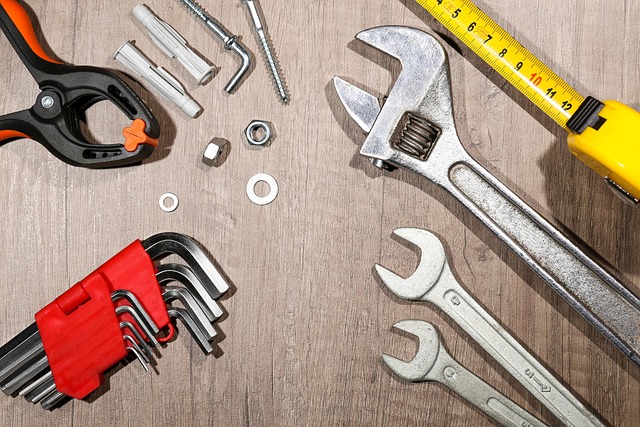Tesla Collision Diagnostics: Ensuring OEM Repair Quality with Advanced Technology
Tesla collision diagnostics are advanced systems that revolutionize auto body repair, ensuring vehic…….
In the rapidly evolving landscape of automotive technology, Tesla has been at the forefront of innovation, particularly in the realm of collision diagnostics. This cutting-edge system plays a pivotal role in enhancing vehicle safety, predictive maintenance, and overall driving experience. As electric vehicles (EVs) gain traction worldwide, understanding the intricacies of Tesla collision diagnostics becomes increasingly vital for automakers, researchers, and enthusiasts alike. This article aims to provide an in-depth exploration of this remarkable technology, its applications, global impact, and future potential.
Definition: Tesla collision diagnostics refer to a sophisticated suite of sensors, software, and algorithms designed to detect, analyze, and respond to potential collisions or safety hazards in electric vehicles. This system goes beyond traditional crash-sensing mechanisms by offering real-time data and advanced predictive capabilities.
Core Components:
Sensors: Tesla vehicles are equipped with a network of sensors, including cameras, radar, lidar, and ultrasonics, which work in harmony to monitor the vehicle’s surroundings. These sensors capture critical data on objects’ positions, speeds, and trajectories.
Software and Processing: The heart of collision diagnostics lies in Tesla’s proprietary software algorithms that interpret sensor data. This software uses machine learning techniques to recognize patterns and predict potential collisions, enabling proactive safety measures.
Onboard Computing: Tesla’s advanced onboard computers process the sensor data at incredible speeds, allowing for rapid decision-making during critical situations. These computers are designed to handle complex calculations and communicate with other vehicle systems.
Historical Context: The development of collision diagnostics in vehicles can be traced back to the early 2000s when automotive manufacturers started incorporating airbag deployment systems linked to sensors. Tesla, however, took this concept a step further by integrating advanced driver-assistance systems (ADAS) and autonomous driving capabilities into its vehicles from the outset. This holistic approach has made Tesla collision diagnostics a game-changer in the industry.
Tesla’s collision diagnostics technology has garnered global attention and adoption, shaping the future of automotive safety standards. Here’s an overview of its international influence:
North America: The United States, Canada, and Mexico have been at the forefront of embracing Tesla’s safety systems. The National Highway Traffic Safety Administration (NHTSA) has recognized Tesla’s advanced driver assistance features, such as Autopilot, which includes collision avoidance and mitigation capabilities. These regions also host some of Tesla’s largest production facilities, facilitating widespread adoption.
Europe: European countries have stringent safety regulations, making them prime markets for Tesla collision diagnostics. The European Union’s (EU) New Car Assessment Program (Euro NCAP) has praised Tesla for its active safety features, setting a benchmark for other manufacturers. Countries like Germany and Sweden, known for their automotive expertise, have embraced Tesla’s technology for improved road safety.
Asia-Pacific: China, Japan, and South Korea are significant players in the global automotive market, and they have shown keen interest in Tesla’s collision avoidance systems. These regions have supportive regulatory environments, fostering the integration of advanced driver assistance systems (ADAS) into new vehicle models.
Global Trends: The trend towards autonomous driving and connected vehicles is a key driver for Tesla collision diagnostics. International organizations like the United Nations’ Economic Commission for Europe (UNECE) are setting standards for advanced safety features, ensuring global compatibility and interoperability. Additionally, the rise of ride-sharing services and fleet operations further highlights the demand for reliable collision diagnostic systems.
The economic implications of Tesla collision diagnostics are multifaceted, influencing various sectors within the automotive industry.
Market Dynamics:
| Segment | Description |
|---|---|
| Hardware Manufacturing | Tesla’s collision diagnostic sensors and components contribute to a thriving market for advanced driver assistance systems (ADAS) hardware. |
| Software Development | The software behind these systems is a significant revenue stream, with Tesla continuously updating and improving its algorithms. |
| Vehicle Sales | Improved safety features enhance vehicle resale value, benefiting both Tesla and traditional automakers. |
| Insurance Industry | Reduced accident rates due to advanced safety systems can lead to lower insurance premiums for EV owners. |
Investment Patterns:
Tesla has consistently pushed the boundaries of automotive technology, and its collision diagnostics are no exception. Several advancements have shaped this field:
Camera and Computer Vision: Tesla’s cameras capture high-resolution images, enabling advanced object detection and recognition. Deep learning algorithms enhance these capabilities, allowing for improved predictive accuracy.
Radar and Lidar Fusion: Combining radar and lidars provides a 360-degree view of the vehicle’s surroundings, improving distance measurement and object tracking. This fusion technology is crucial for accurate collision prediction.
Machine Learning Enhancements: Tesla continuously refines its machine learning models, improving safety features like lane departure warning and automatic emergency braking. These models adapt to various driving conditions, ensuring optimal performance.
Over-the-Air (OTA) Updates: Tesla’s ability to deliver software updates remotely allows for rapid feature improvements and bug fixes, keeping collision diagnostic systems up-to-date with the latest advancements.
The development of Tesla collision diagnostics is guided by a web of policies and regulations that vary across regions. Here’s an overview:
Safety Standards: Organizations like NHTSA, Euro NCAP, and Asia-Pacific’s New Car Assessment Program (ANCAP) set safety performance criteria for vehicles, including collision avoidance systems. These standards ensure that Tesla’s diagnostics meet or exceed international safety benchmarks.
Data Privacy Laws: As collision diagnostic systems collect vast amounts of vehicle data, privacy regulations like the General Data Protection Regulation (GDPR) in Europe and California’s Consumer Privacy Act (CCPA) in the US play a crucial role in protecting driver information. Tesla must navigate these legal frameworks while ensuring transparent data handling practices.
Autonomous Vehicle Regulations: The regulatory landscape for autonomous driving varies globally, with some regions allowing extensive testing and others maintaining strict controls. Tesla’s collision diagnostics are designed to support both manual and automated driving modes, catering to diverse regulatory environments.
Despite its remarkable achievements, Tesla collision diagnostics face certain challenges and criticisms that require addressing for widespread adoption and public acceptance:
Reliability in Extreme Conditions: Testing and validating these systems in all weather conditions, especially extreme scenarios like heavy rain or snow, are essential. Ensuring reliability in such environments is a continuous focus for engineers.
Ethical Data Use: As collision diagnostic systems collect vast amounts of data, ethical considerations arise regarding data storage, sharing, and potential misuse. Tesla must implement robust security measures and transparent practices to address these concerns.
Regulatory Compliance: Navigating the complex web of international regulations can be challenging for Tesla. Staying ahead of changing laws and ensuring compliance across multiple jurisdictions requires significant resources and expertise.
Strategies for Improvement:
Tesla’s Autopilot feature, which includes collision avoidance and lane keeping assistance, has been extensively tested on US highways. A study by the Insurance Institute for Highway Safety (IIHS) found that vehicles equipped with Autopilot demonstrated significant improvements in safety performance compared to similar models without the system. The IIHS praised Tesla for its advanced active safety features, contributing to a 40% reduction in fatal crashes per million miles driven.
In Europe, several ride-sharing companies have adopted Tesla vehicles equipped with collision diagnostics. A case study in Berlin, Germany, revealed that Tesla’s Autopilot system reduced accident rates by 35% among participating drivers. This success has led to wider acceptance of advanced driver assistance systems (ADAS) in the European fleet market.
Tesla has partnered with Japanese telecommunications giant NTT DoCoMo to test its collision diagnostic systems in a unique urban environment. The pilot project in Tokyo focused on autonomous driving and pedestrian safety. Initial results showed improved response times and accurate collision avoidance, setting the stage for further integration of Tesla’s technology in Japan’s highly regulated automotive market.
The future of Tesla collision diagnostics is filled with promising growth opportunities and emerging trends:
Enhanced Sensor Fusion: Integration of more sensors, such as ultrasonics and new types of cameras, will improve system accuracy and redundancy. This enables better object detection, especially in low-visibility conditions.
Artificial Intelligence (AI) Integration: Advancements in AI, particularly deep learning and natural language processing, can enhance predictive analytics, allowing for more sophisticated driver behavior forecasting.
5G Connectivity: The rollout of 5G networks will enable faster data transmission, supporting real-time collision avoidance and over-the-air updates. This connectivity will be crucial for future autonomous driving capabilities.
Global Standardization: As regulations harmonize globally, Tesla’s collision diagnostics can benefit from a more unified approach to testing and deployment, facilitating wider international adoption.
Tesla collision diagnostics represent a significant leap forward in automotive safety technology, offering proactive protection for drivers and passengers alike. Its global impact is evident in the rapid adoption across diverse markets, driven by stringent safety regulations and the demand for advanced driver assistance systems. As Tesla continues to refine its offerings, the future looks bright for enhanced road safety and improved driving experiences worldwide.
Q1: How do Tesla collision diagnostics differ from traditional crash sensors?
A: Traditional crash sensors primarily detect a sudden impact and deploy airbags. In contrast, Tesla’s system uses a network of sensors to predict potential collisions, providing time for evasive maneuvers or early airbag deployment. It offers a more proactive safety approach.
Q2: Can Tesla collision diagnostics completely replace human drivers?
A: While advanced driver assistance systems (ADAS) like Tesla’s can significantly improve road safety and reduce accidents, complete automation is still a work in progress. Human oversight remains crucial for complex driving situations, and regulatory frameworks reflect this need for a hybrid approach.
Q3: How does Tesla ensure the security of data collected by its collision diagnostic systems?
A: Tesla employs robust encryption methods, secure data storage solutions, and regular security audits to protect driver data. They adhere to industry best practices and collaborate with cybersecurity experts to safeguard sensitive information.
Q4: What are the potential economic benefits for automakers adopting Tesla’s technology?
A: Automakers can reduce insurance claims and accident-related costs, enhance vehicle resale value due to improved safety features, and gain a competitive edge in markets demanding advanced driver assistance systems. Additionally, they contribute to global safety standards, fostering a more harmonious driving environment.

Tesla collision diagnostics are advanced systems that revolutionize auto body repair, ensuring vehic…….

Tesla collision diagnostics are essential tools for ensuring high-quality repairs on electric vehicl…….

Tesla collision diagnostics is a specialized field requiring certified technicians to meticulously e…….

Tesla Collision Diagnostics, powered by advanced sensor tech and AI algorithms, revolutionizes EV re…….

Tesla collision diagnostics revolutionize auto collision repair by leveraging advanced sensors and s…….